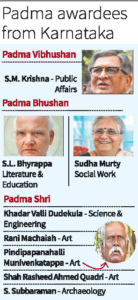Published on: January 26, 2023
Padma awards
Padma awards
Why in news? The government announced one Padma Vibhushan and 25 Padma Shri awards.
Highlights
- The President of India has approved 106 Padma awards.
- The list comprises six Padma Vibhushan, nine Padma Bhushan and 91 Padma Shri awards.
- Nineteen of the awardees are women and the list includes seven honoured posthumously.
Padma awards for Karnataka
- Veteran politician M. Krishna selected for the Padma Vibhushan and noted Kannada novelist S.L. Bhyrappa and Infosys Foundation chairperson Sudha Murty has been selected for the Padma Bhushan.
- From Karnataka those who chosen for the Padma Shri are Khadar Valli Dudekula (Science & Engineering), Rani Machaiah (Art), Pindipapanahalli Munivenkatappa (Art), Shah Rasheed Ahmed Quadri (Art), and S. Subbaraman (Archaeology).
Padma Awards for India
- Samajwadi Party patriarch Mulayam Singh, architect Balkrishna Doshi and Dilip Mahalanabis,( popularised the use of Oral Rehydration Solution while serving at a refugee camp during the 1971 Bangladesh War) , will be honoured with the Padma Vibhushan posthumously, the country’s second highest civilian award
- Ramkuiwangbe Newme, a Naga social worker from Dima Hasao in Assam, won the Padma Shri.
- Composer M.M. Keeravani, who recently won the Golden Globe, has also been recognised with the Padma Shri.
What are Padma Awards ?
- Padma Awards are India’s highest civilian honours after the Bharat Ratna,
- They were instituted in the year 1954, is announced every year on the occasion of Republic Day except for brief interruption(s) during the years 1978 and 1979 and 1993 to 1997.
- The total number of awards to be given in a year (excluding posthumous awards and to NRI/foreigners/OCIs) should not be more than 120.
- The award is normally not conferred posthumously. However, in highly deserving cases, the Government could consider giving an award posthumously.
The award is given in three categories, namely,
- Padma Vibhushan for exceptional and distinguished service
- Padma Bhushan for distinguished service of a high order and
- Padma Shri for distinguished service.
- All persons without distinction of race, occupation, position or sex are eligible for these awards.
- However, Government servants including those working with PSUs, except doctors and scientists, are not eligible for these Awards.
What is the history of the awards?
- Two awards, the Bharat Ratna and Padma Vibhushan were first instituted in 1954 as India’s highest civilian honours.
- The latter had three classes: Pahela Varg (1st Class), Dusra Varg (Second Class) and Tisra Varg (Third Class). In 1955, these were subsequently named as Padma Vibhushan, Padma Bhushan and Padma Shri respectively.
Who decides the award ?
- All nominations received for Padma Awards are placed before the Padma Awards Committee, which is constituted by the Prime Minister every year.
- The Padma Awards Committee is headed by the Cabinet Secretary and includes Home Secretary, Secretary to the President and four to six eminent persons as members.
- The recommendations of the committee are submitted to the Prime Minister and the President of India for approval.
Note:
- The awardees do not get any cash reward but a certificate signed by the President apart from a medallion which they can wear at public and government functions.
- The awards are, however, not a conferment of title and the awardees are expected to not use them as prefix or suffix to their names.
- While a Padma awardee can be given a higher award (i.e. a Padma Shri awardee can receive a Padma Bhushan or Vibhushan), this can only happen after five years of the conferment of the previous award.
- If they do not seek to receive the award, they can refuse at that time and their names will be removed without any noise.
- While extremely rare, the President of India can annul/cancel someone’s Padma award in case of any egregious misconduct committed by the recipient

